Braking 101: The What, Why and How
Whether you are brand new to mountain biking or you’ve been riding for many years, it’s important that you have a baseline understanding of what your brakes do, why they are important and exactly how to use them. Having a solid braking foundation will allow you to build up to more advanced braking technique, and more advanced terrain!
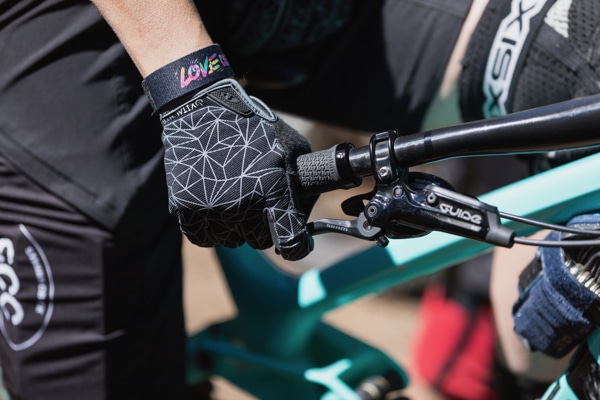
What
You have two brake levers on your bike. In the US, a standard bike setup has the front brake on the left and the rear brake on the right (Think: Right Rear). In other parts of the world (i.e.; New Zealand, UK, Australia …) these are reversed!
Left Brake ➡️ Front Brake
Right Brake ➡️ Rear Brake
Your front and rear brake are arguably equally important and both serve a slightly different purpose. Let’s dive in…
Front Brake
Your front brake has your stopping power. Why is this? The front of the bike dips down when you apply your brakes and because of this, there is more weight on the front of the bike and thus more traction on the front tire. This means the front tire is less likely to skid. It also means, you must brake with good technique and body position to prevent being slung forward (or over-the-handlebars, “OTB”). More on body position in a minute!
Rear Brake
Your rear brake helps you to control your speed, but depending on terrain, may not necessarily be all that great at bringing you to a full stop. You may have noticed that you rear tire is more likely to skid.
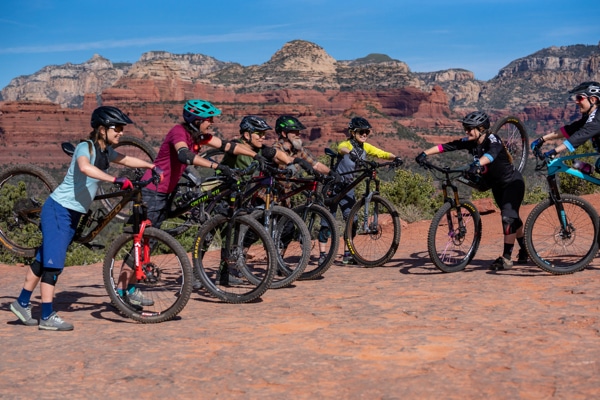
Test It Out
It can be helpful to see for yourself, how these brakes function. Try the following drill:
- Grab your bike by the handlebars and stand off to the side, facing forward.
- With your hands on the bars apply pressure to only your back brake and push the bike forward. You should notice it dragging behind you but the bike would still move forward. This is a good indication that your rear brake may not the best at bringing you to a complete stop!
- Then, try only applying pressure to only your front brake and push the bike forward. You should notice how the bike would not move forward and your rear wheel might even lift. Bam – that front brake has considerably more stopping power!
- Now, put one foot on your pedal and push your heels down to weight the pedal at the same time you apply pressure to your front brake. Ah ha! You should notice the back wheel stays down and your bike doesn’t move
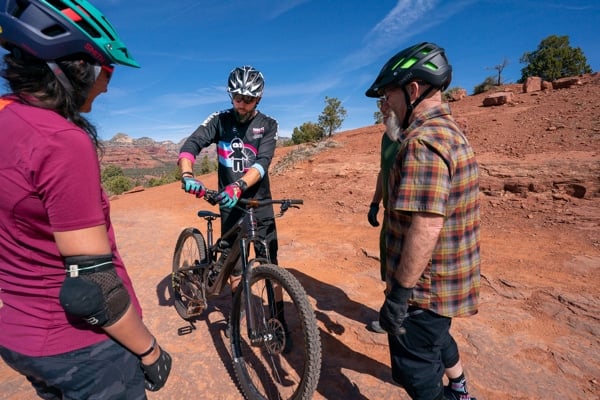
Brake Setup
In order to use your brakes effectively, it is important that your brakes are setup correctly. You should be braking with your index finger and only your index finger.
You should adjust the positioning of your brake levers so that your index finger naturally lines up with the bend in the brake lever. This will give you better bike control, a better feel for what the brakes and tires are doing and give you greater confidence in your riding. When checking for this index finger / brake lever alignment, make sure your hands are completely on the hand grips — if the side of your hand is hanging off the bars (grips) you’ll be putting pressure on your Ulnar nerve. This pressure can cause numbness in your hand and arm, fatigue, discomfort and diminished control of your bike.
For further explanation on one finger braking, checkout this article.
Why
You use your brakes both to control your speed while riding and to bring yourself to a complete stop. Sometimes you will have the runway to gradually slow yourself down and other times, you might need to quickly and safely bring yourself to a stop (think: cliff!).
How
Now that we understand what each brake does and why they are important, it’s time to dive into the HOW of braking. Here are the key components:
- One finger braking. The correct way to brake is using just one finger, your index finger.
- Ease the squeeze. You should never grab the brake lever and immediately pull it all the way back to the grip. Rather, you should gradually squeeze the lever, or “ease the squeeze” as we like to say. Think of using your brakes like squeezing toothpaste out of a bottle. When applying toothpaste to your toothbrush, you don’t squeeze the bottle as hard as possible, right? I hope not! You gently squeeze the bottle until the perfect amount of toothpaste has been applied, and then you release.
- Use both brakes. Generally speaking, you should be using both brakes when slowing or stopping. In our Braking 201 article, we will cover more advanced braking techniques and when you might use only your front brake or only your rear brake.
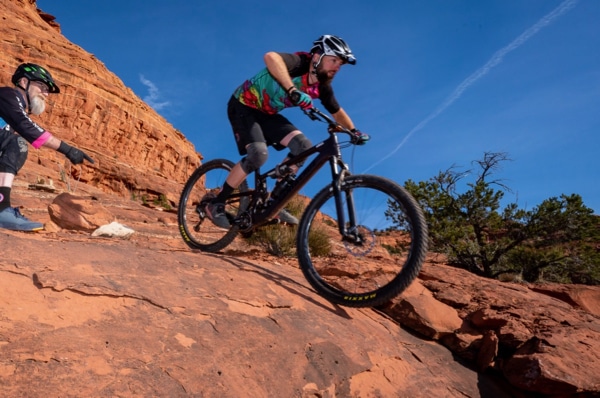
Body Position
It is hugely important to have proper body position on the bike at all times, and especially when you are braking. The key components to good body position are:
- Heels dropped + toes up
- Body low (bend those knees!). Lowering your center of gravity in this way gives you more stability and drives your weight down into your tried more evenly for greater traction.
- Weight in your feet and light hands on the handlebars. The more of your weight you can drive down into the pedals, the lighter you are on you handlebars.
- Relax your arms (don’t lock out those elbows!)
How (Much)
How much and/or how quickly you want to slow or stop will determine how quickly you apply the above principles.
Need to come to a stop or reduce your speed quickly? You’ll want to apply your front brake and back brake at the same time while simultaneously shifting your weight low and back and dropping your heels to weight your pedals, in a quick “STOMP” like motion. This will help you to avoid tumbling forward!
Simply want to control your speed or slow down a little? You will still want to have your heels dropped, knees bent and weight in your feet. Rather than a quick STOMP, you stay loose in the body and adjust your body position as you apply your brakes to stay balanced and centered over the bike.
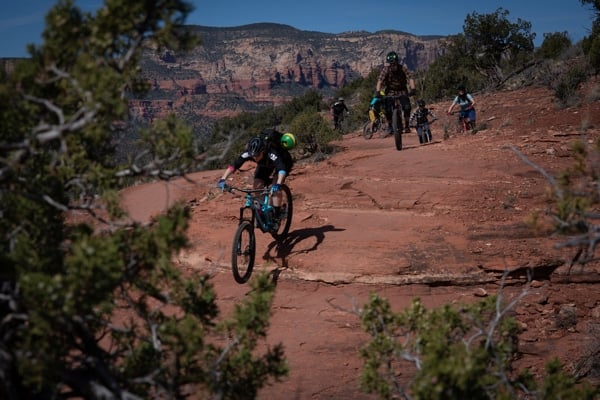
All Together Now
Braking is not as simple as ON / OFF. There is an art and a science to using your brakes effectively and believe it or not, “good” braking can make you a faster rider. Yup, that’s right; smoother is faster. So start by dialing in the key principles detailed above and you’ll be well on your way to tackling more advanced braking techniques and more advanced terrain with confidence.
Are you still feeling a bit unstable when you use your brakes? Nervous about going over the handlebars? Looking for in-person feedback on your braking technique? We can help! Join us for a Fundamentals clinic where we cover the foundations of braking and check out a 2-Day Camp to progress to more advanced technique and terrain.






I’ve been riding MTB for 24 years and feel like I just now learned how to brake properly. Thanks Singletracks!
I enjoy the vice of braking into the apex as late as possible, done right momentum is preserved. The acceleration through the apex from slowing down before the corner just is not as fun, even if faster.
My old school roots have me use the rear brake to make the front heavy, traction does increase with use tho diminishing returns await chronic use.
Great article! I think it’s smart for any beginning mountain biker to learn braking and basic fire road handling on a completely rigid bike due to the additional feedback you get from the bike – the rider can feel exactly what is going on with both the bike and their body position. A rigid front fork really hones braking technique as well as keeping the upper body loose to “float” over obstacles on the trail. Modern suspensions forgive so many ham fisted mistakes that one can get bad habits ingrained and when they do crash it is at a much higher speed. Don’t get me wrong, I’ve got a trail bike with almost 6″ of travel front and back and it’s great fun, but learning old school first has its benefits.
Skids are for kids and roadies!
Take pride in leaving no mark!
Skids are the result of way too late or lazy and improper braking!
Front brake keeps you straight, rear brake means you can make a tighter turn. You shouldn’t be front braking into a tight corner – you’ll run wide on the exit and it can get dicey.